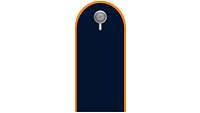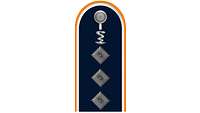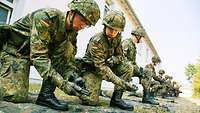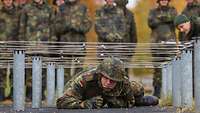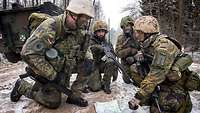Senior noncommissioned officers
Leaders, instructors, specialists – senior NCOs need to have expertise and experience, and they must be on good terms with their subordinate servicemen and women.
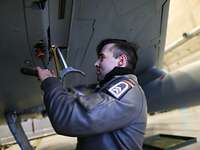
Senior noncommissioned officers – military leaders, specialists and instructors
The senior noncommissioned officer rank category comprises sergeant and equivalent ranks from OR-6 to OR-9. In the Navy, these ranks are petty officers from OR-6 to OR-9.
In German, the names of the NCO ranks refer to the “Portepee”, the sword knot traditionally looped around the hilt of a sword. Senior NCOs and officers had such a loop, whereas lower ranks did not.
In the Army and Air Force, the senior NCO ranks are “Feldwebel” (sergeant; OR-6), “Oberfeldwebel” (staff or technical sergeant, senior grade; OR-6), “Hauptfeldwebel” (master sergeant or sergeant first class; OR-7), “Stabsfeldwebel” (master sergeant or senior master sergeant; OR-8) and “Oberstabsfeldwebel” (chief master sergeant or sergeant major; OR-9). In the Navy, these ranks are called “Bootsmann” (petty officer first class; OR-6), “Oberbootsmann” (petty officer first class, senior grade; OR-6), “Hauptbootsmann” (chief petty officer; OR-7), “Stabsbootsmann” (senior chief petty officer; OR-8) and “Oberstabsbootsmann” (master chief petty officer; OR-9).
Officer candidates – the braid makes the difference
Future officers also pass through the senior noncommissioned officer ranks. In the Army and the Air Force, these ranks are called junior officer cadet (OR-6) and senior officer cadet (OR-7/OR-8). In the Navy, they are petty officer first class (naval officer cadet; OR-6) and chief petty officer (naval officer cadet; OR-7/OR-8).
Their rank insignia only differ in detail from those of the senior NCOs who are not officer candidates. The junior officer cadet wears the same rank insignia as a staff sergeant or technical sergeant, whereas the rank insignia of the senior officer cadet resembles that of the master sergeant or sergeant first class. Only a piece of silver cord distinguishes the officer candidates. In the Bundeswehr, it is known as the “silver braid”. In the Navy, the rank insignia is complemented by a golden star instead of a silver braid for future officers.
In some cases, however, there are exceptions to this rule. A staff sergeant or technical sergeant changing from a senior NCO career to a line officer or specialist officer career, for example, has the added abbreviation “OAOffiziersanwärter"
Experience and competence
Senior noncommissioned officers can choose different specialisations – whether in line service, the general specialist service, the geoinformation service, the military music service or the medical service.
In line service, senior NCOs stand before their subordinate servicemen and women every day as, for example, team leaders, squad leaders or platoon leaders to train, educate and lead them.
Military personnel who have successfully completed vocational training or master craftsman’s training in an area relevant to the Bundeswehr can be employed in the general specialist service, for example, as senior aircraft NCOs, expediters or senior fire protection NCOs. Depending on their professional qualifications and experience, they can already start their employment with a higher rank.
In the geoinformation service, possible careers for senior NCOs include geoinformation meteorological technician and geoinformation surveyor. In the military music service, senior NCOs may be employed as orchestral musicians, for example.
And in the medical service, senior NCOs are specialists in their fields: as independent medics, paramedics, medical technologists or surgical assistants.
The regular tour of duty of a senior NCO is 15 years. Depending on the intended assignment or the relevance of previous qualifications, tours of duty may also be shorter or longer. Senior noncommissioned officers can also become career service members.
| Rank | Minimum period of service | NATONorth Atlantic Treaty Organization rank |
|---|---|---|
Staff sergeant/technical sergeant/petty officer first class | 3 years | OR-6 |
| Junior officer cadet/petty officer first class (naval officer cadet) | 21 months | OF-D |
| Staff sergeant, senior grade/technical sergeant, senior grade/petty officer first class, senior grade | 5 years | OR-6 |
| Sergeant first class/master sergeant/chief petty officer | 8 years | OR-7 |
| Senior officer cadet/chief petty officer (naval officer cadet) | 30 months | OF-D |
| Master sergeant/senior master sergeant/senior chief petty officer | 16 years as a senior NCO | OR-8 |
| Sergeant major/chief master sergeant/master chief petty officer | 19 years as a senior NCO | OR-9 |



